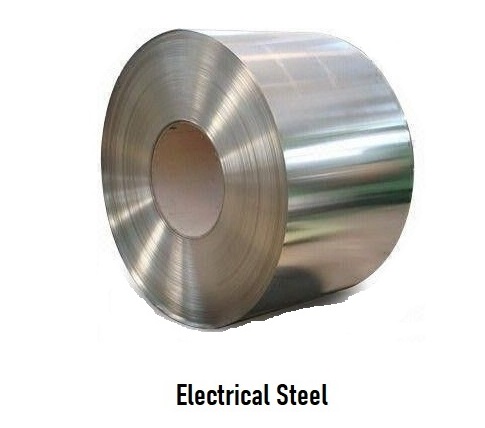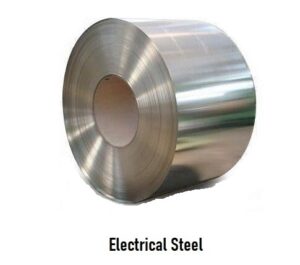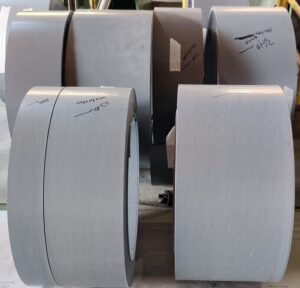
Electrical steel is a magnetic material with better electrical properties. It is used in many electromagnetic devices, like control panel relays, magnetic solenoids, electric AC and DC motors, AC and DC generators, and much more. Silicon steel sheet, transformer CRGO silicon steel sheet, and lamination steel are some additional names for electrical steel. It is predominantly used in the automotive and power distribution sectors.

Describe electrical steel.
Electrical steel sheet is a ferromagnetic iron-based material that has anywhere from 1 percent to 6.5 percent silicon (Si) in it. Electrical steels were made because there was a need for steels that could keep heat from escaping, which wastes energy in electrical equipment. Even though an iron core was found to be the least expensive option, it could have better impurities.

It was discovered that adding silicon enhances permeability, reduces hysteresis loss, and increases resistivity. Because steels containing more silicon are too brittle to be cold rolled, the most economically available electrical steel contains approximately 3.25 percent Si of silicon. When it comes to electromagnetic and electrical properties, electrical steel with 6.5 percent Si is the best. However, its brittleness and low ductility require further thermomechanical procedures.
Electrical Properties of electrical steel.
The physical characteristics of electrical steel are significantly enhanced by adding silicon to iron. Electrical steels are great for generating, distributing, and using electricity because they have the following qualities:
- Increased ability to support electromagnetic fields due to high permeability.
- Low magnetostriction means little tendency to grow or shrink in electromagnetic fields.
- Core loss is lowered by low eddy current due to high electrical resistivity.
- Reduced hysteresis loss – A low hysteresis loss indicates less heat from alternating magnetizing force expended.
Various kinds of electrical steel
Fully processed non-oriented electrical steel
Electrical steel that has been fully treated and is not oriented can have anywhere from 0.5% Si to 3.2% Si by weight of silicon. It has constant magnetic properties in many directions. This kind of electrical steel doesn’t need to be crystallized in order for its properties to develop. Reduced silicon alloy grades offer better thermal conductivity and electromagnetic permeability. People think that higher alloy grades will work better at high frequencies with less loss. This kind is ideal for electromagnetic circuits in the housing of electrical systems, transformers, and motors. The completed annealing process on this completely treated type makes it harder to punch. Organic coatings are included to improve lubrication during the punching process.
Semi-processed, non-oriented electrical steel
Non-oriented silicon, semi-processed electrical steel sheets are mostly made of steels that don’t contain silicon and are rolled and annealed at low temperatures. On the other hand, the final stress-relieving anneal must be done by the end user after the steel has served its purpose. This kind of electrical steel is better at taking a punch than the fully treated, non-oriented type. Hence, organic coatings are not necessary. Non-oriented silicon and semi-processed grades are ideal for tiny rotors, stator blades, and power transformer cores.
Grain-oriented electrical steel
Electrical steels with grain orientation provide excellent permeability and minimize energy loss. They are made of iron with a 3% Si component. Strong crystallographic characteristics are present in grain-oriented grades. This kind goes through a process called “recrystallization,” which changes the structure of the grains to make them more magnetic in the direction that the sheet rolls. Transformers and other non-rotating applications are the main uses for grain-oriented steels.

Density 7.65 g/cm³.
Thickness 0.21,0.23,0.27,0.30,0.35 mm
Elongation 6-14%
Hardness, Rockwell B 75-85%
Hardness 175-195
Tensile strength 330-370 Mpa
Temperature 840 C
Electrical resistivity 4.8E-7 ohm M
What applications are there for electrical steel?
Electrical steels are useful in many types of electrical systems due to their magnetic performance. The following are some uses for electrical steel cores:
Rotating machines:
- The Electrical Vehicle
- The driving motors
- The hermetic motor.
- (AC & DC) motors.
Static machines:
- Transformers for both distribution and power.
- both magnetic amplifiers and reactors.
- arc welding transformers
- transformers for audio.
- CT/PT Current transformers potential transformer .
- Relays and Electromagnetic switches.
- electrical ballast

Leave a Reply